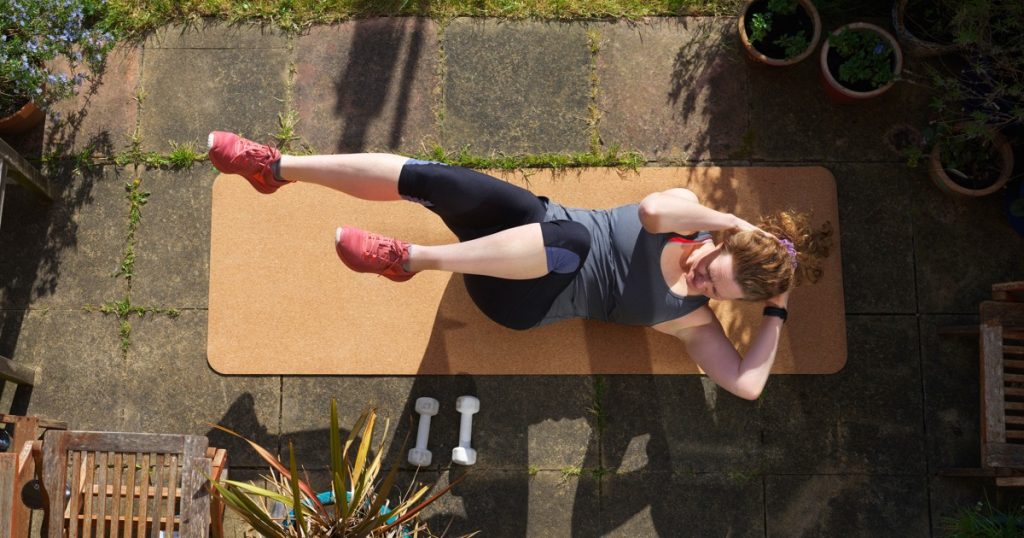Summarize this content to 2000 words in 6 paragraphs Welcome to Start TODAY. Sign up for our Start TODAY newsletter to receive daily inspiration sent to your inbox — and join us on Instagram!Many people want to know the ideal amount of time to dedicate to exercise. My clients often ask me how much time do they need to spend on workouts to lose weight and see other changes in their bodies. I often recommend a 20-minute walk for people who are new to fitness — and this is the basis of our monthly workout plans for members of our Start TODAY community. People should focus on the importance of getting up and moving, not how many minutes they spend on an exercise. Many tell themselves, “If I can’t do 30 minutes on the treadmill, I may as well skip it,” so they don’t exercise at all. But that isn’t true — it’s still better to move than to sit.Even Jennifer Aniston would tell herself she had to work out for 45 minutes, she shared with TODAY. Aniston said she used to exhaust herself with the “no pain, no gain” approach, but she realized it was more sustainable to work out for shorter periods.Aniston will push herself to do at least ten minutes, “I can do anything for ten minutes,” she said. Adding that if she does even that small amount, “I’ll immediately feel incredible. You just instantly start to feel those endorphins and that energy. ”How long should a workout last?If you’re new to exercise, start slowly. Eventually you can work up to the CDC recommendation of 150 minutes of moderate activity per week, or 30 minutes of moderate exercise per day. Or, you could aim for 75 minutes of vigorous activity per week. New to exercise? Start with 5-minute workoutsGetting into the habit of exercising is a mental challenge as well, and starting with workouts that are too long and ambitious can make it hard to stay motivated. But, as Aniston said, after just a few minutes of exercise, you’ll feel better about your body and boost your mood, so I always advise people to start small. This is why I create so many five-minute workout plans and stretch routines for people to squeeze in to their day. You’ll be surprised how much better you feel after committing to just five minutes and it will help you overcome the biggest hurdle: getting started and sticking with it. The most effective routine, that will show you results, is one you stick to consistently. So start there.Ready to commit to a solid workout routine? Aim for 20-minute workoutsIf you have the time, I always start my clients at 20 minutes of movement per day. Initially, it doesn’t matter what type of movement: a walk, run, yoga, stretching, Pilates, core work, HIIT workouts — anything is great!Bite off an exercise goal that you can chew — and chew it consistently.Starting with 20 minutes gives you enough time to warm up and push yourself to your max effort before cooling down. Eventually, working up to 30 minutes a day is ideal, but my motto is that slow and steady wins the race! Bite off an exercise goal that you can chew — and chew it consistently.After you’re able to commit to the 20 minutes of movement a day consistently for a few weeks, I then recommend fine tuning your routine by focusing on your goals and choosing a type of exercise accordingly. Typically, my clients are stressed and holding onto fat in their midsection. So I recommend choosing a form of exercise that helps them de-stress. It may be going on a walk, sweating it out with a HIIT workout or having some fun by doing some dance cardio. If toning is the goal, start to incorporate 20 minutes of strength training a few days each week.Once 20 minutes of movement is a habit, choose strategic 30-minute workoutsOnce you’ve made 20-minute workouts a habit, you can start to increase the amount of time you’re exercising to that recommended 30 minutes a day.Does thinking about committing to 30 minutes a day seem overwhelming? That’s OK. Following this two-step plan of attack will help you get there: First, start with five minutes a day to prove to yourself that you can habitually exercise. Then, work on steadily increasing your workout time by 5-minute increments to 10 minutes, then 15, and so on. The gradual increase will have you hitting that 30-minute mark in no time. And don’t forget that three, ten-minute walks throughout the day or two, 15-minute strength sessions countMore of your questions, answered:


